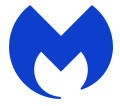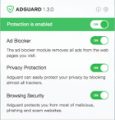What is ModuleService
ModuleService is an application that functions as adware. Adware is a type of malware which displays unwanted advertisements to the user of a computer. The advertisements produced by adware are sometimes in the form of a advertising banner, text links, fake alert, pop up or sometimes in an unclosable window. Adware software can seriously affect privacy, computer’s performance and security.
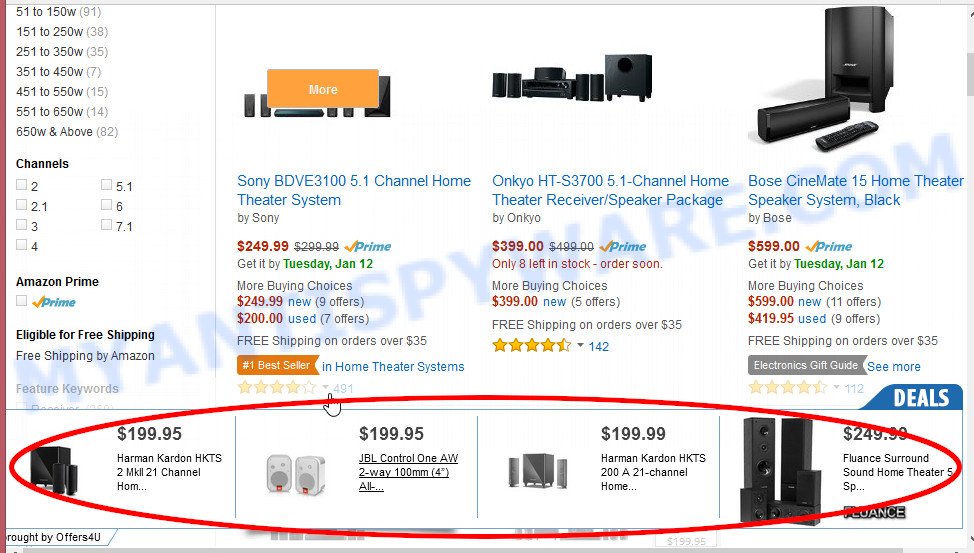
Unwanted ads
Does adware steal your personal data? The ModuleService adware has the ability to gather and transmit privacy info without your permission. It is able to track information about web-sites visited, web browser and system information, and your Apple Mac IP address. If you are unfortunate have adware software or malware running on your Mac, you can follow the steps here to delete ModuleService from your computer and browser.
How does ModuleService get on your MAC system
Adware is bundled within certain free software. So always read carefully the install screens, disclaimers, ‘Terms of Use’ and ‘Software license’ appearing during the install procedure. Additionally pay attention for third-party applications which are being installed along with the main program. Ensure that you unchecked all of them! Also, use an adblocker application that will help to block suspicious and untrustworthy websites.
Threat Summary
| Name | ModuleService, ModuleService 1.0 app |
| Type | adware, potentially unwanted application (PUA), Mac malware, Mac virus |
| Detection Names | Adware/Adload!OSX, MacOS.Agent-MT, OSX.Trojan.Gen, ApplicUnwnt, Adware.MAC.Generic, Trojan-Downloader.OSX.Adload, Osx.Adware.Cimpli and Program:MacOS/Vigram.A |
| Distribution | Freeware installers, fake updaters, malicious popup advertisements and torrent downloads |
| Symptoms | The webpage links redirect to a webpages different from what you expected, advertising links appear in places they shouldn’t be, unwanted program installed without your say-so, an unexpected toolbar appears in your browser, your web-browser start page has replaced without your permission, slow browsing Internet. |
| Removal | ModuleService removal guide |
How to Remove ModuleService adware (removal steps)
When the adware gets installed on your computer without your knowledge, it is not easy to remove. In most cases, there is no Uninstall tool which simply uninstall the ModuleService adware from your computer. So, we suggest using well-proven free specialized utility like MalwareBytes Free. But the best solution to remove ModuleService adware will be to perform several manual steps, after that additionally run antimalware tools.
To remove ModuleService, perform the steps below:
- Remove unwanted profiles on Mac device
- Remove ModuleService related programs through the Finder
- Remove ModuleService related files and folders
- Scan your Mac with MalwareBytes
- Remove ModuleService from Safari, Chrome, Firefox
- How to stay safe online
Remove unwanted profiles on Mac device
ModuleService can install a configuration profile on the Mac system to block changes made to the browser settings. Therefore, you need to open system preferences, find and delete the profile installed by the adware.
Click the System Preferences icon ( ![]() ) in the Dock, or choose Apple menu (
) in the Dock, or choose Apple menu ( ![]() ) > System Preferences.
) > System Preferences.
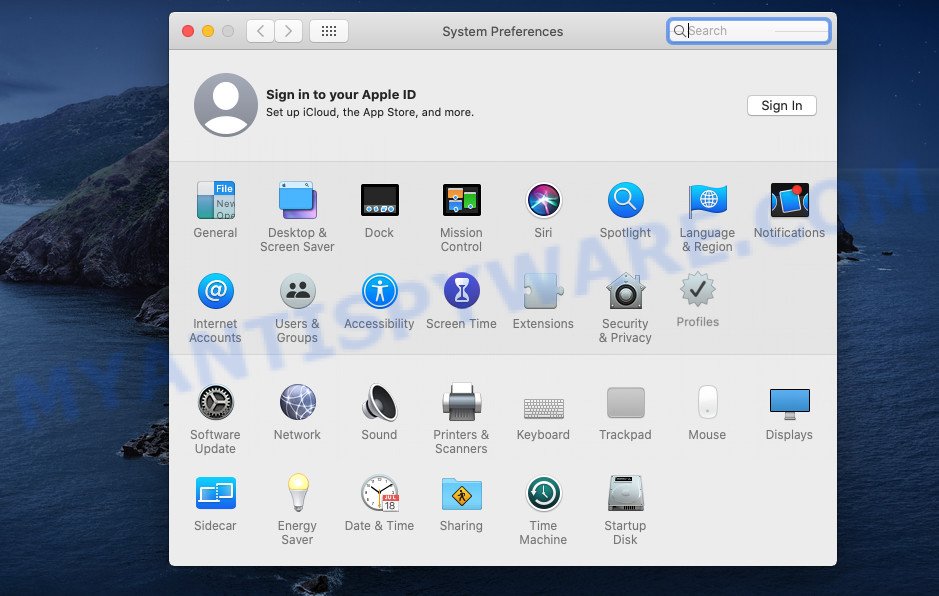
In System Preferences, click Profiles, then select a profile associated with ModuleService.
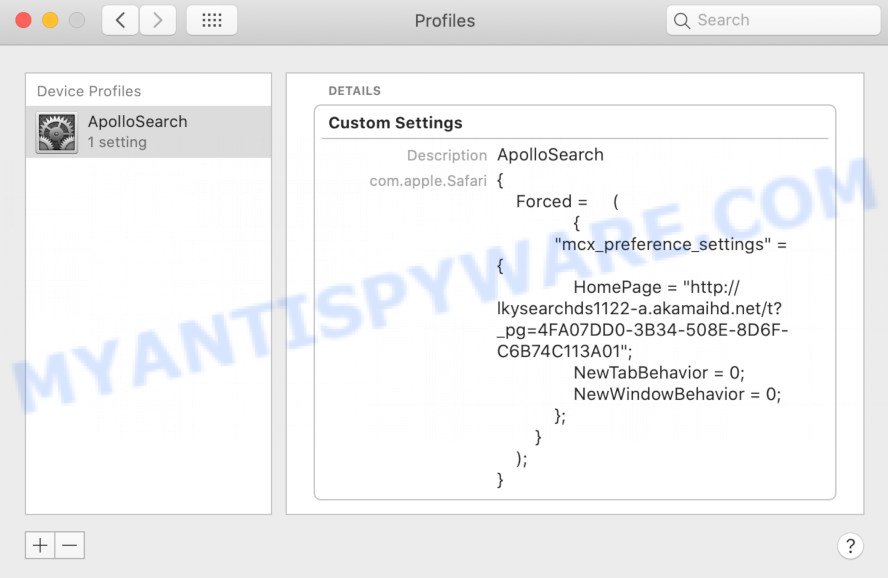
Click the minus button ( – ) located at the bottom-left of the Profiles screen to remove the profile.
Note: if you do not see Profiles in the System Preferences, that means there are no profiles installed on your Mac, which is normal.
Remove ModuleService related programs through the Finder
It is of primary importance to identify and get rid of PUPs, adware and browser hijackers through ‘Applications’ section of your Finder.
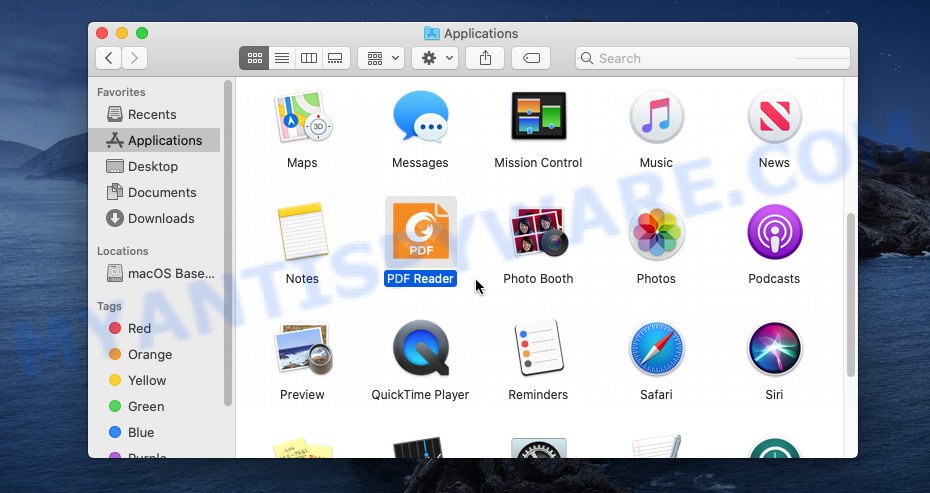
- Open the Finder.
- Click “Applications”.
- It will open a list of all apps installed on the MAC OS.
- Scroll through the all list, and remove suspicious and unknown programs. Pay maximum attention to the program you installed last.
- Drag the questionable program from the Applications folder to the Trash.
- Empty Trash.
Remove ModuleService related files and folders
Now you need to try to find ModuleService related files and folders, and then delete them manually. You need to look for these files in certain directories. To quickly open them, we recommend using the “Go to Folder…” command.
ModuleService creates several files, these files must be found and removed. Below is a list of files associated with this unwanted program.
- /Library/LaunchDaemons/com.ModuleService.system.plist
- ~/Library/LaunchAgents/com.ModuleService.service.plist
- /Library/Application Support/.(RANDOM)/System/com.ModuleService.system
- ~/Library/Application Support/.(RANDOM)/Services/com.ModuleService.service.app
Some files created by ModuleService are hidden from the user. To find and delete them, you need to enable “show hidden files”. To do this, use the shortcut CMD + SHIFT + . Press once to show hidden files and again to hide them. There is another way. Click Finder -> Applications -> Utilities -> Terminal. In Terminal, paste the following text: defaults write com.apple.finder AppleShowAllFiles YES

Press Enter. Hold the ‘Option/alt’ key, then right click on the Finder icon in the dock and click Relaunch.
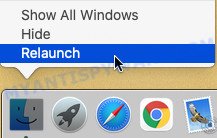
Click on the Finder icon. From the menu bar, select Go and click “Go to Folder…”. As a result, a small window opens that allows you to quickly open a specific directory.

Check for ModuleService generated files in the /Library/LaunchAgents folder

In the “Go to Folder…” window, type the following text and press Go:
/Library/LaunchAgents
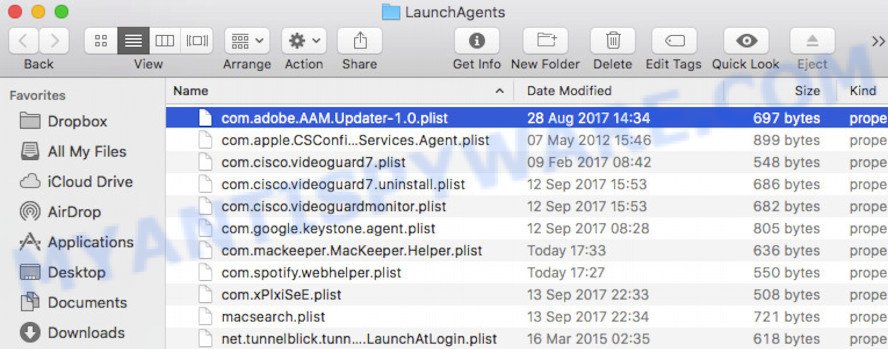
This will open the contents of the “/Library/LaunchAgents” folder. Look carefully at it and pay special attention to recently created files, as well as files that have a suspicious name. Move all suspicious files to the Trash. A few examples of files: com.machelper.plist, com.ModuleService.service.plist, com.google.defaultsearch.plist, , installapp.plist, macsearch.plist, com.net-preferences.plist and search.plist. Most often, potentially unwanted programs, browser hijackers and adware software create several files with similar names.
Check for ModuleService generated files in the /Library/Application Support folder

In the “Go to Folder…” window, type the following text and press Go:
/Library/Application Support
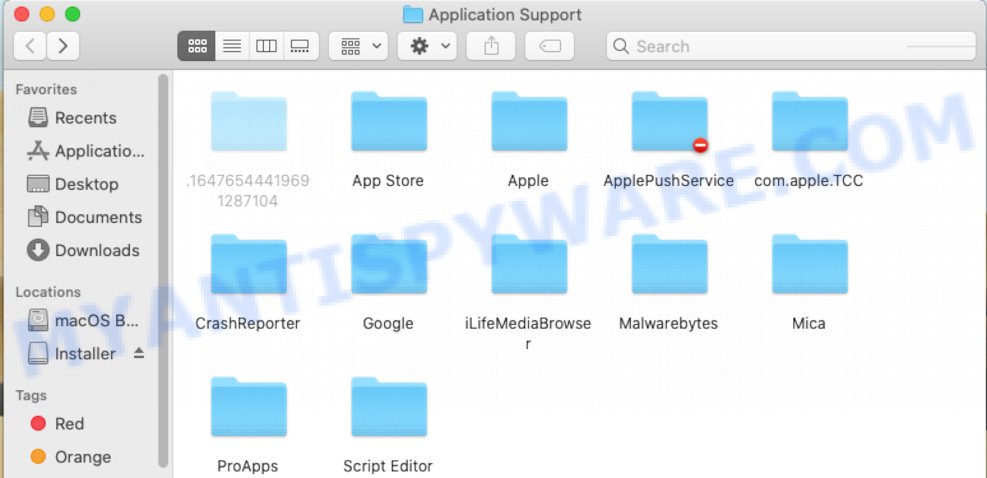
This will open the contents of the “Application Support” folder. Look carefully at its contents, pay special attention to recently added/changed folders and files. Check the contents of suspicious folders, if there is a file with a name similar to com.ModuleService.system, then this folder must be deleted. Move all suspicious folders and files to the Trash.
Check for ModuleService generated files in the “~/Library/LaunchAgents” folder

In the “Go to Folder…” window, type the following text and press Go:
~/Library/LaunchAgents

Proceed in the same way as with the “/Library/LaunchAgents” and “/Library/Application Support” folders. Look for suspicious and recently added files. Move all suspicious files to the Trash.
Check for ModuleService generated files in the /Library/LaunchDaemons folder
In the “Go to Folder…” window, type the following text and press Go:
/Library/LaunchDaemons

Carefully browse the entire list of files and pay special attention to recently created files, as well as files that have a suspicious name. Move all suspicious files to the Trash. A few examples of files to be deleted: com.ModuleService.system.plist, com.macsearch.system.plist, com.installapp.system.plist, com.search.system.plist and com.machelper.system.plist. In most cases, PUPs, browser hijackers and adware software create several files with similar names.
Scan your Mac with MalwareBytes
You can delete ModuleService associated files automatically through the use of MalwareBytes Free. We suggest this free malware removal tool because it may easily delete browser hijackers, adware, toolbars and PUPs with all their components such as files, folders and system entries.
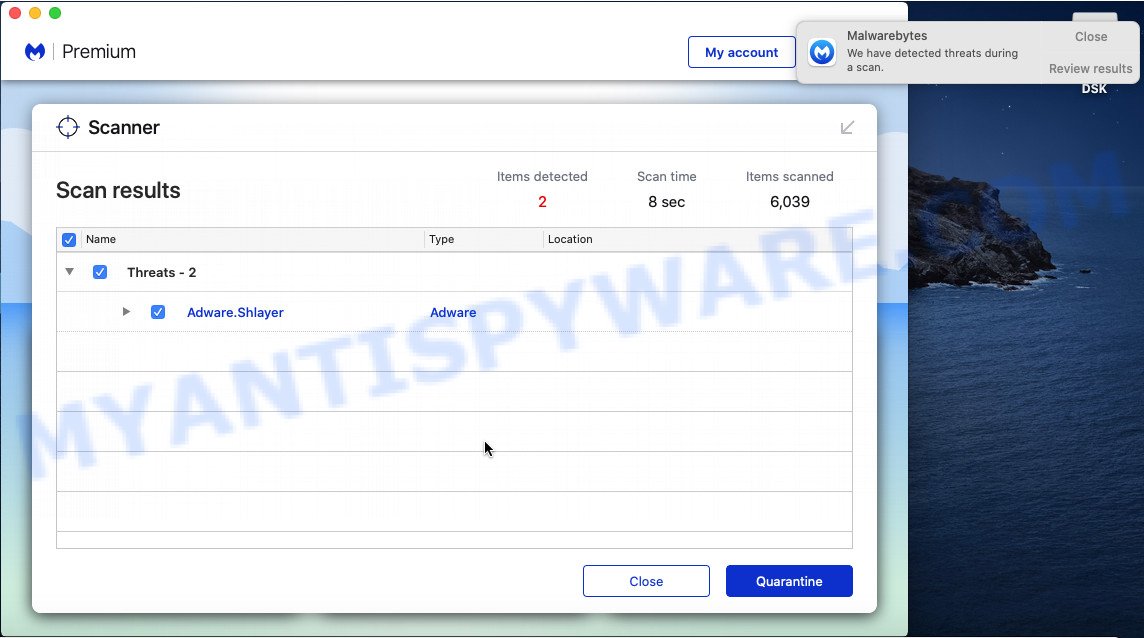
- MalwareBytes can be downloaded from the following link.
Malwarebytes Anti-malware (Mac)
21024 downloads
Author: Malwarebytes
Category: Security tools
Update: September 10, 2020
- When the downloading process is finished, please close all software and open windows on your MAC OS. Run the downloaded file. Follow the prompts.
- The MalwareBytes Anti Malware (MBAM) will launch and display the main window.
- Further, click the “Scan” button to detect ModuleService adware. During the scan MalwareBytes will find threats present on your MAC.
- Once the scan is finished, MalwareBytes Anti-Malware (MBAM) will open a list of found threats.
- Make sure to check mark the threats that are unsafe and then click the “Remove Selected Items” button.
- Close the Anti Malware and continue with the next step.
Remove ModuleService from Safari, Chrome, Firefox
Annoying ModuleService adware software or other symptoms of adware software in your web-browser is a good reason to find and get rid of malicious add-ons. This is an easy way to recover web-browsers settings and not lose any important information.
You can also try to get rid of ModuleService adware by reset Google Chrome settings. |
If you are still experiencing issues with ModuleService adware software removal, you need to reset Firefox browser. |
|
How to stay safe online
The AdGuard is a very good adblocker program for the Mozilla Firefox, Google Chrome and Safari, with active user support. It does a great job by removing certain types of unwanted ads, popunders, pop ups, annoying new tabs, and even full page ads and website overlay layers. Of course, the AdGuard can block malicious web pages automatically or by using a custom filter rule.
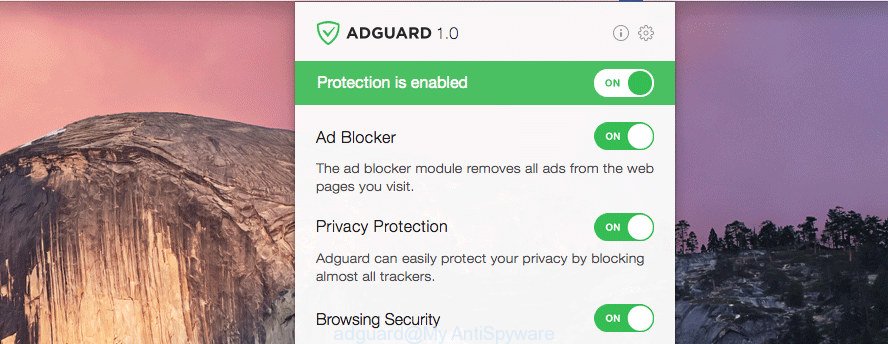
- AdGuard can be downloaded from the following link.
AdGuard for Mac download
3782 downloads
Author: © Adguard
Category: Security tools
Update: January 17, 2018
- After downloading is complete, launch the downloaded file. You will see the “Setup Wizard” program window. Follow the prompts.
- When the install is finished, click “Skip” to close the setup program and use the default settings, or click “Get Started” to see an quick tutorial that will assist you get to know AdGuard better.
- In most cases, the default settings are enough and you don’t need to change anything. Each time, when you launch your MAC, AdGuard will launch automatically and stop unwanted advertisements, block harmful and misleading web pages.
To sum up
After completing the steps shown above, your computer should be free from ModuleService and other malicious software. The Safari, Mozilla Firefox and Chrome will no longer redirect you to various unwanted web sites. Unfortunately, if the guide does not help you, then you have caught a new adware software, and then the best way – ask for help here.
